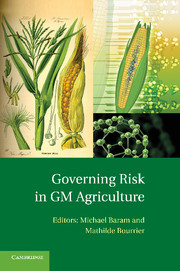Book contents
- Frontmatter
- Contents
- Preface
- Contributors
- 1 Governing Risk in GM Agriculture
- Part I Risk Governance and Public Discourse
- 2 Governance of GM Crop and Food Safety in the United States
- 3 The European Union's Regulatory Framework
- 4 The Dutch Approach to Safety Governance of GM Agriculture
- 5 Evolution of the Regulatory System for GM Crops in Brazil
- Part II Future Challenges
- Index
3 - The European Union's Regulatory Framework
Developments in Legislation, Safety Assessment, and Public Perception
Published online by Cambridge University Press: 01 March 2011
- Frontmatter
- Contents
- Preface
- Contributors
- 1 Governing Risk in GM Agriculture
- Part I Risk Governance and Public Discourse
- 2 Governance of GM Crop and Food Safety in the United States
- 3 The European Union's Regulatory Framework
- 4 The Dutch Approach to Safety Governance of GM Agriculture
- 5 Evolution of the Regulatory System for GM Crops in Brazil
- Part II Future Challenges
- Index
Summary
Introduction
Over the first fourteen years of commercialization of genetically modified (GM) crops, the acreage of GM crops has consistently grown each year, with the number of countries increasing from 6 in 1996 to 25 and a global area of 134 million hectares in 2009. Herbicide-tolerant soybean continued to be the principal GM crop, followed by insect and/or herbicide tolerant maize, cotton, and rapeseed. The United States, Brazil, Argentina, India, Canada, China, Paraguay, and South Africa are the major growers with 64 to 2.1 million hectares of GM crops, followed by Uruguay, Bolivia, the Philippines, Australia, Burkina Faso, Spain, and Mexico with 0.8 to 0.1 million hectares of GM crops. Among the ten countries that grew less than 50.000 hectares are the European Union (EU) member-states Czech Republic, Portugal, Romania, Poland, and Slovakia.
Many countries have established regulatory frameworks with regard to the deliberate release of genetically modified organisms (GMO) and derived products in the early 1990s. Two types of regulatory systems can be distinguished. Whereas some countries, such as the United States and Canada, have enacted “product-based” legislations, the EU's regulatory system for GMO and derived foods and feeds is “process based.”
Directives on the Deliberate Release of GMO
The EU began to govern the deliberate release of GMO into the environment in 1990 when Directive 90/220/EEC entered into force. The scope of this Directive covered experimental releases as well as the placing on the market of GMO for cultivation, import, and/or processing.
- Type
- Chapter
- Information
- Governing Risk in GM Agriculture , pp. 57 - 84Publisher: Cambridge University PressPrint publication year: 2010
- 1
- Cited by



